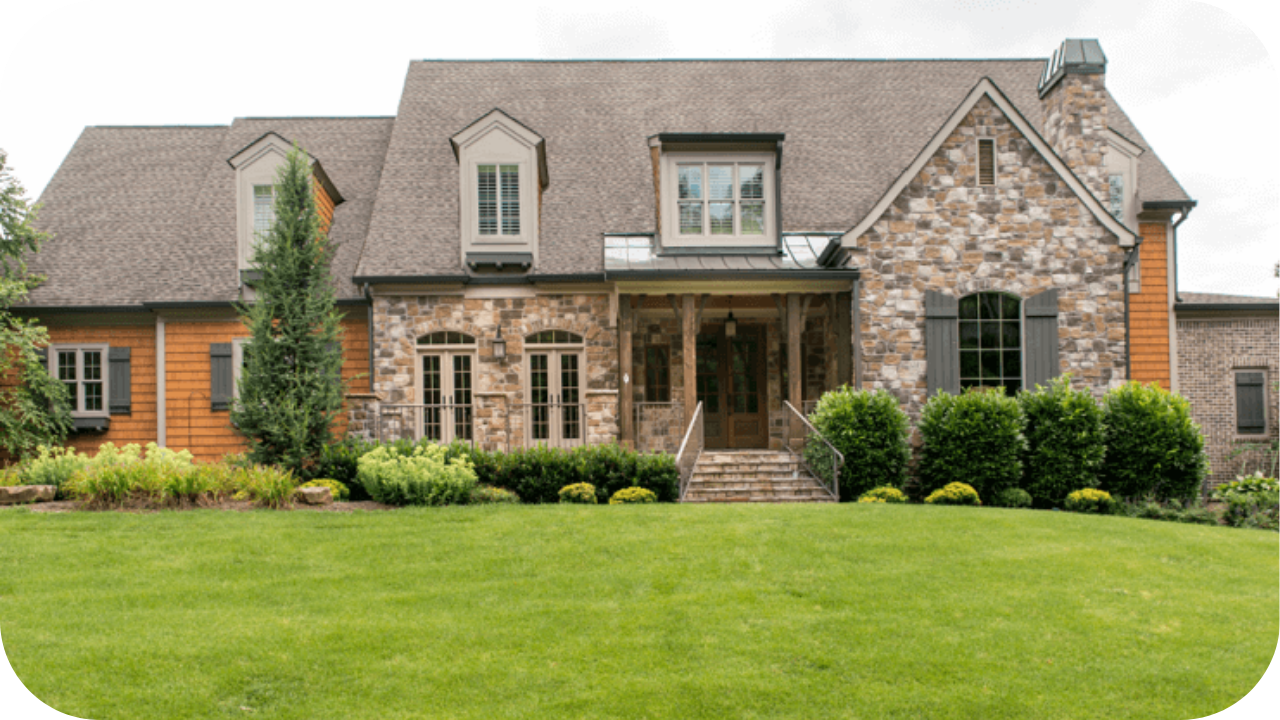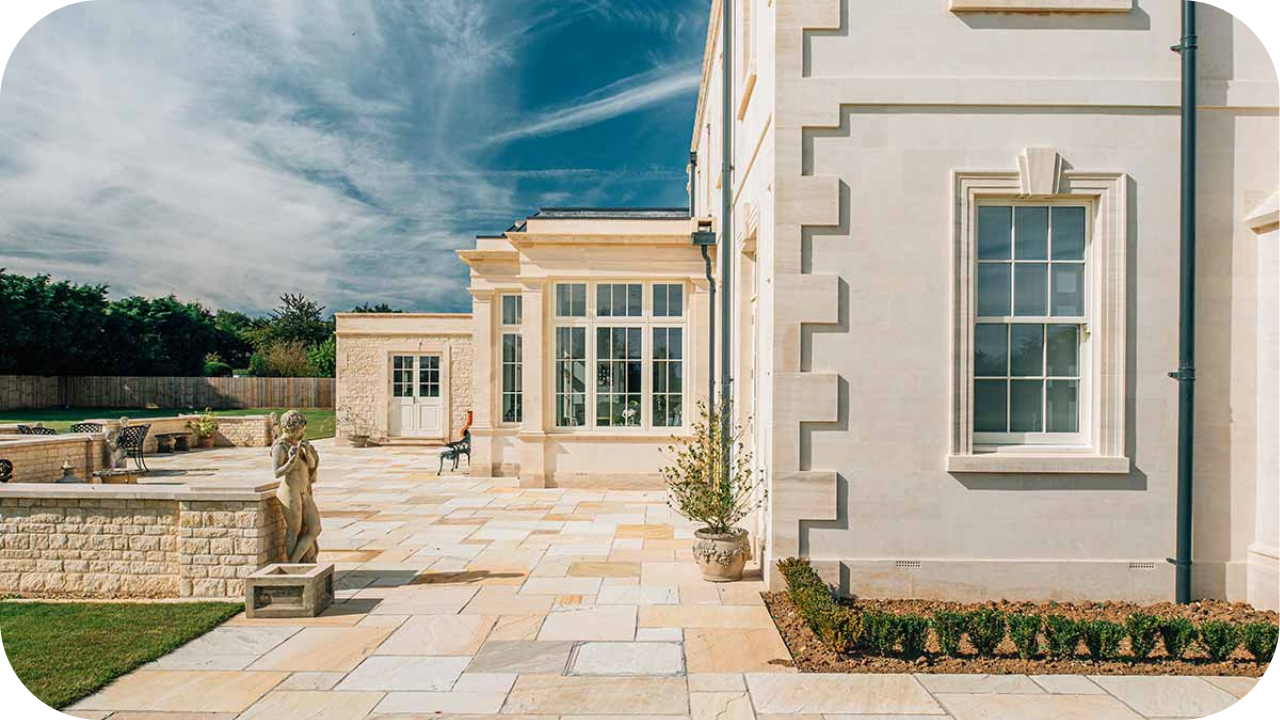
Maintaining sandstone cladding in humid climates can be challenging, as excess moisture often leads to deterioration and unsightly stains.
The persistent humidity can seep into the sandstone, promoting algae growth and weakening the stone’s integrity. This not only affects the aesthetic appeal but also threatens the structural safety of your property.
Fortunately, there are effective strategies to protect and preserve your sandstone cladding. In this article, we’ll explore the best practices for sealing, cleaning, and routine maintenance to ensure your sandstone remains durable and visually appealing, even in the toughest climates.
Understanding Sandstone Cladding
Sandstone cladding serves as a popular decorative feature for both interior and exterior walls, valued for its natural beauty and range of colours, from beiges and browns to more exotic reds and oranges.
This cladding type involves thin layers of sandstone being applied to walls to give the appearance of solid blocks. Sandstone is particularly favoured for its unique textures and patterns, which can add a rustic or elegant touch to buildings.
However, sandstone’s porosity is a critical factor to consider, especially in humid climates. Its porous nature means it can absorb moisture easily, which can lead to various forms of damage such as cracking, spalling, and discoloration over time. This absorption can also promote the growth of algae and moss, which further deteriorates the stone’s surface and may compromise the structural integrity of the cladding.
In regions with high humidity, proper installation and maintenance of sandstone cladding are crucial. Ensuring that the stone is properly sealed and that any moisture can escape without becoming trapped behind the cladding is essential to preserve the aesthetic appearance and longevity of the sandstone.
Effects of Humidity on Sandstone Cladding
- Moisture Absorption: Sandstone’s porosity allows it to absorb moisture, leading to expansion and contraction. This cycle causes physical stress within the stone, resulting in cracking or spalling that damages both the aesthetic and structural integrity of the cladding.
- Biological Growth: Moist environments are ideal for algae, fungi, and moss growth. This growth discolours the sandstone and retains further moisture, increasing the damage over time. The biological layer can make surfaces skiddy, presenting a safety hazard.
- Efflorescence: As moisture within the sandstone evaporates, it leaves behind salt deposits. These deposits, known as efflorescence, can be tough to remove and may permanently alter the stone’s appearance.
- Thermal Expansion and Contraction: Humidity can enhance the thermal expansion and contraction of sandstone, especially when combined with temperature fluctuations. This dynamic can accelerate the deterioration process, leading to more frequent and severe cracking and spalling.
To combat these effects, it is essential to treat and maintain sandstone cladding in humid climates with effective moisture management strategies and regular cleaning to prevent biological growth and salt build-up.
Preventive Maintenance
Effective preventive maintenance is crucial to preserving sandstone cladding in humid climates. The primary goal is to minimize moisture penetration and manage environmental impacts that can degrade the stone. Here are key strategies for maintaining sandstone cladding:
- Sealing: Apply a high-quality sealant specifically designed for natural stone. This sealant forms a protective barrier that repels water while allowing the stone to breathe. It is essential to reapply sealant periodically, following manufacturer recommendations, usually every two to five years.
- Proper Installation: Ensure that sandstone cladding is installed with adequate drainage systems to prevent water accumulation. The back of the cladding should include a ventilated cavity that allows any absorbed moisture to evaporate and air to circulate, reducing the risk of water damage.
- Regular Cleaning: Clean the cladding regularly using gentle methods such as soft brushing or low-pressure washing to remove dirt, debris, and biological growth. Avoid harsh chemicals or high-pressure washers, which can damage the sandstone.
- Routine Inspections: Conduct visual inspections regularly to identify early signs of moisture-related damage such as discoloration, algae growth, or salt deposits. Early detection can prevent minor issues from becoming severe, reducing long-term repair costs.
Cleaning and Maintenance Routine
Establishing a thorough cleaning and maintenance routine is essential for preserving sandstone cladding in humid climates. Here’s a detailed approach:
- Scheduled Cleaning: Conduct biannual cleaning sessions to remove accumulated dirt, debris, and biological growth. Use soft brushes and mild, pH-neutral cleaners specifically formulated for natural stone. Avoid acidic solutions and high-pressure washing, which can erode the surface of the sandstone.
- Spot Cleaning: Between scheduled cleanings, perform spot cleaning as needed to address stains or biological growth like moss and algae. Use a soft cloth or sponge with a stone-safe cleaning solution. For stubborn stains, a poultice may be applied to draw out the discoloration.
- Sealing: After cleaning, allow the sandstone to dry completely, then apply a breathable sealant to protect against moisture penetration. This should be done every two to five years, depending on the exposure and manufacturer’s recommendations.
- Inspection: Regularly inspect the cladding for signs of damage such as cracks, loose pieces, or efflorescence. Early detection and repair of these issues can prevent more extensive damage and costly repairs.
- Documentation: Keep a log of all maintenance activities, including dates, products used, and observations. This record can help track the condition of the cladding over time and optimize the maintenance schedule..
Sealing and Protective Measures
Implementing effective sealing and protective measures is vital for safeguarding sandstone cladding against the adverse effects of humidity. Here are essential steps to ensure optimal protection:
- Choosing the Right Sealant: Select a high-quality sealant that is specifically designed for natural stone, particularly sandstone. The sealant should provide a breathable, moisture-resistant barrier without trapping moisture within the stone, which could cause further damage.
- Application Process: The application of the sealant should occur after thorough cleaning and complete drying of the sandstone surface. Apply the sealant evenly using a brush, roller, or sprayer, ensuring full coverage. Follow the manufacturer’s instructions regarding the number of coats required and the necessary drying time between applications.
- Reapplication Schedule: Sealant effectiveness can diminish over time, especially in humid environments. It is generally recommended to reapply sealant every two to five years, but this can vary based on the exposure to moisture and the product used. Regular inspections can help determine when reapplication is necessary.
- Additional Barriers: In extremely humid areas, consider additional protective measures such as weather barriers behind the cladding to prevent moisture ingress from the back side. Ensure proper installation to allow any trapped moisture to escape and prevent accumulation.
Addressing Efflorescence and Salt Deposits
Efflorescence and salt deposits are common issues for sandstone cladding in humid environments, arising from salts within the stone migrating to the surface and crystallizing as moisture evaporates. Effectively managing these issues is essential for maintaining the aesthetic and structural integrity of the cladding. Here’s how to address them:
- Early Detection: Regularly inspect sandstone cladding for the white, powdery residue characteristic of efflorescence. Early detection allows for simpler, more effective removal before the salts penetrate deeply or cause surface pitting.
- Cleaning Method: To remove efflorescence, use a dry, soft brush to gently scrub the affected areas. For persistent or large-scale deposits, a mild solution of water and vinegar can be used sparingly. After applying the solution, thoroughly rinse the area with clean water to remove any residual acid which could further damage the stone.
- Preventive Measures: Minimize the recurrence of efflorescence by ensuring that the cladding is properly sealed with a breathable sealant that prevents moisture ingress yet allows vapor to escape. Additionally, improve drainage and ventilation around the cladding to reduce moisture accumulation.
- Regular Maintenance: Incorporate the cleaning of salt deposits into the regular maintenance schedule for the cladding. Keeping the stone clean and dry as much as possible is key to preventing the formation of new efflorescence.
Dealing with Mold, Mildew, and Algae Growth
Mold, mildew, and algae growth are common issues for sandstone cladding in humid climates due to the stone’s natural porosity, which allows moisture retention. These organisms not only mar the aesthetic appeal of the cladding but can also cause structural damage over time. Here’s how to effectively manage these problems:
- Regular Cleaning: Establish a routine cleaning schedule using a soft brush and a solution of mild, pH-neutral soap mixed with water. This will help remove any existing growth and prevent new spores from taking hold.
- Targeted Treatments: For areas heavily affected by mold, mildew, or algae, apply a cleaning solution formulated for killing these organisms. Ensure the product is safe for use on sandstone to avoid damaging the stone. Apply the solution according to the manufacturer’s directions, typically allowing it to sit on the surface for a period before rinsing thoroughly with clean water.
- Improving Ventilation: Enhance air circulation around the cladding to reduce moisture accumulation. This can be achieved by trimming vegetation that may block airflow and adjusting landscaping to avoid direct contact with the cladding.
- Use of Preventive Products: Consider applying a mold inhibitor that is compatible with sandstone after cleaning. This product will provide an additional layer of protection by making the surface less hospitable to mold and algae.
Regular Inspection and Repair
Consistent inspection and timely repair are critical for maintaining the integrity and appearance of sandstone cladding in humid climates. Here’s a focused approach to ensure your cladding remains in top condition:
- Frequency of Inspections: Conduct visual inspections of the sandstone cladding at least twice a year. Additional checks should follow any severe weather events that could exacerbate existing issues or introduce new vulnerabilities.
- What to Look For: During inspections, look for signs of damage such as cracks, loose stones, or areas of discoloration that may indicate moisture penetration. Also, check for efflorescence, mold, or algae growth which can signal excessive moisture retention within the cladding.
- Immediate Action: If any issues are identified, immediate action is required to prevent further damage. Small cracks and loose pieces should be repaired using appropriate materials and techniques that match the existing cladding. Ensure that any repairs maintain the cladding’s ability to breathe, preventing moisture buildup.
- Professional Assessment: For extensive damage or complex issues, consult a professional specializing in stone cladding. Their expertise will ensure that repairs are properly executed, which is essential for the longevity and safety of the cladding system.
Conclusion: Proactive Care
Maintaining sandstone cladding in humid climates requires diligence and proactive care. Regularly inspect, clean, seal, and repair your cladding to prevent lasting damage and preserve its beauty.
Don’t wait for visible signs of wear; act now to protect your investment.
Consult a professional for tailored advice and ensure your sandstone remains a testament to timeless elegance.
More To Explore

Hamptons-Style Homes and the Right Stone to Match
Hamptons-style homes are synonymous with timeless elegance, offering a perfect blend of coastal charm and sophisticated design. With their light, airy feel and use of

Luxury Looks: Styling Stone in Contemporary Homes
Stone has long been associated with luxury, and in contemporary homes, it brings sophistication and timeless charm. From sleek marble countertops to the warmth of


